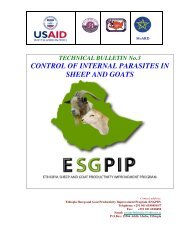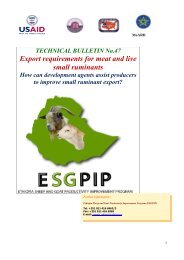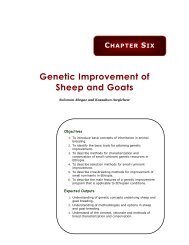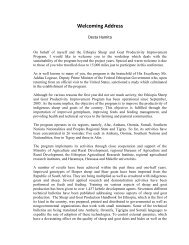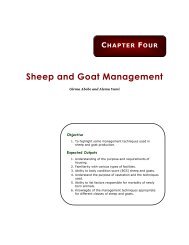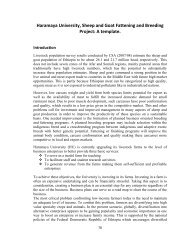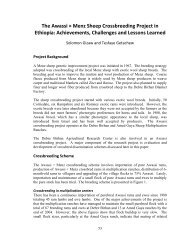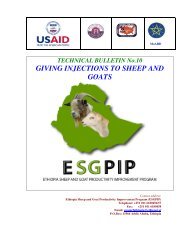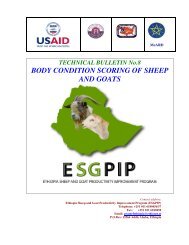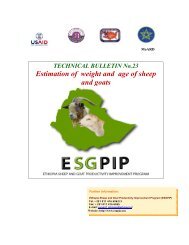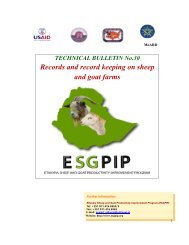Technical bulletin N.. - esgpip
Technical bulletin N.. - esgpip
Technical bulletin N.. - esgpip
You also want an ePaper? Increase the reach of your titles
YUMPU automatically turns print PDFs into web optimized ePapers that Google loves.
ForewordThis <strong>Technical</strong> Bulletin titled “Methods in sheep and goat technology extension” is the 37 thproduced by the Ethiopia Sheep and Goat Productivity Improvement Program (ESGPIP). TheESGPIP is a USAID funded Project with the objective of improving the productivity of Ethiopia’ssheep and goats.If improved technology is to achieve real impact on farm productivity and livelihoods, appropriatemethodologies for dissemination of information have to be used. Experience has shown thatdevelopment agents need to be equipped not only with the technical knowhow on sheep and goatproduction but also have the skill and knowledge to deliver this to their clients.This technical <strong>bulletin</strong> presents some methods and approaches of technology extension. It isbelieved that this will help bridge the gap in this regard and help the effective transfer of sheep andgoat production technologies.At this juncture, I would like to thank all those involved in the preparation and review of thistechnical <strong>bulletin</strong>.Desta Hamito (Prof.),Chief of Party,ESGPIPJune, 2010i
Methods in Sheep & Goat Technology ExtensionPrepared by: Gezahegn TadesseEdited by: Alemu Yami, R.C. Merkel and T. Gipson1. IntroductionRural farmers, agro-pastoralists and pastoralists have raised sheep and goats for generations andrecognize them as an integral part of their agricultural production system. Sheep and goats areutilized for meat, hair, milk, skins, manure, and for income generation. Furthermore, small ruminantproduction plays important roles in social security, religious rituals, etc.Despite Ethiopia’s immense sheep and goat resources, their contribution to the country’s economyis insignificant mainly due to their low productivity. The production of meat from Ethiopian sheepand goats averages 10 and 9 kilograms, respectively, compared to 13.5 kilograms of sheep meat and13.1 kilograms of goat meat for East African countries. One of the reasons for low productivity ofEthiopian sheep and goats is lack of and/or weak extension services in sheep and goat production.A strong, effective, efficient and sustainable extension delivery system is essential to realizeimprovements in productivity.The demand for information on sheep and goat production is growing both in the sense of demandsexpressed by producers themselves and in a more general sense of a growing desire for increasingproduction and livelihood of producers through the delivery of information.This technical <strong>bulletin</strong> provides small ruminant extension and development approaches that willassist Development Agents (DA) and Animal Health Technicians (AHT) to transfer necessaryknowledge and skills to sheep and goat producers effectively.2. What is agricultural extension?Agricultural extension can be defined as the application of communication and learning activities totransfer “proven” technologies, practices and skills to producers of agricultural commodities.Accordingly, the objective of sheep and goat extension is to sustainably improve production andproductivity of sheep and goats through technological knowledge and skills combined withindigenous knowledge. Sheep and goat extension will result in better management of sheep andgoats that produce more quality products and consequently generate higher income to the producer.3. Methods of agricultural extensionThese are ways through which new ideas, practices or innovations are transferred/ communicated toproducers. The choice of method or approach depends on the nature of the message, the objectivesto be achieved, the channels to be used, the availability of facility, and literacy level of the targetaudience. The three major methods are described here-under.1
3.1. Individual extension method (IEM)This method involves interaction of the extension worker with the producer on a one-to-onebasis to address individual problems of production. IEM has the following advantages:• It is easy to identify problems and theircauses based on first hand information. Thishelps the extension agent to supply relevantrecommendations to solve particularproblems.• Immediate feedback is obtained on whetherthe message has been understood in the wayintended.• People will listen to the advice andsuggestions of extension staff who they feelthey know personally.DA visiting forage field of farmerThe disadvantages include:• Relatively expensive in terms of time and logistic requirements.• Very few farmers will be reached within a given period.• There is a possibility that extension workers will choose to visit only a few beneficiariesraising the concern of equity.• Requires greater effort of the extension agent.The different means for transferring knowledge and skills to beneficiaries with IEM includewritten (e.g., <strong>bulletin</strong>, leaflet, pamphlets), verbal (e.g., general meeting, conference) andaudiovisuals (e.g., blackboard, flip charts, pictures, photographs, slide films, etc.; home visit,telephone call, office visit by client, music, songs, and tales also are beneficial in IEM.Annex 1 summarizes the planning, implementation and follow-up requirements of theindividual extension method and most common tools.3.2. Group extension method (GEM)This method is when one or more extension workers meet/ communicate with a group offarmers. It aims to develop local skills and empower local people to solve their own problems.This method is particularly suitable when dealing with matters related to the whole communityor village. Advantages of GEM include:Cheaper than IEM in terms of staff time and transportation costs since more people canbe addressed using the same material resources and time.Extension personnel can serve a wider spectrum of clients more equitably.The group approach speeds up learning, attitude change and acceptance of new ideas.Exchange of several points of view in a group makes problem identification, diagnosisand screening of possible solutions easier and more relevant.Reduces transaction costs for input supplies and improves bargaining power during saleof produce. Beneficiaries can also share resources.Groups provide an opportunity for strengthening friendship and teamwork, allowingmembers to share ideas, experiences and problems.Increases personal motivation by creating competitive spirit because of group influence.2
The group method is effective when action needs to be taken collectively.Groups have better chances of getting funding and advice from NGOs or other donors tosupport their development work.DisadvantagesDependent on sufficient mobilization at the grassroots levelIt may take a long time to arrive at a decision.It can sometimes be difficult to get people to agree on issues and to work together.Influential people in a community may divert the group from the desired course ofaction.Individual problems are not addressed in a group.People who are not members of the group will not be reached.Conflict may arise among the group members. The members must have similar interestsand understandings about the group and what it will achieve. The benefits should bedistributed fairly according to the amount of effort each member contributes.There are different tools or means of delivering services through GEM, which include methoddemonstrations and result demonstrations.Method demonstrations: used to introduce new skills/practices and show howsomething is done through a series of steps e.g. urea-molasses block making, ureatreatment of crop residues. Method demonstrations provide opportunity to beneficiariesto trust a technology and adopt it in ashorter period. It is an effective wayof teaching because beneficiariespractice, see, listen and discussduring the demonstration. Severalpeople can be taught at the sametime using method demonstrations.Method demonstrations are effectiveif a limited number of people areinvolved. If there are too manypeople, some of them may not beable to hear, see or practice theDemonstration of urea treatmenttechnique under demonstration.Result demonstrations: intended todemonstrate/show what has happened or beengained because of using a given technology orpractice. The comparison of old practices ortechniques to new ones is a main feature. Resultdemonstrations can be influential in persuadingbeneficiaries to adopt introduced concepts andpractices since they provide evidence of thebenefits of carrying out recommended practices.Demonstration of the effects of supplementationon growth and body condition of lambs could beField day on effect of feedsupplementation3
an example. Result demonstrations can be made during exchange visits, visits toinstitutions, field days or workshops.Annex 2 summarizes the planning, implementation and follow-up requirements of the groupextension method and most common tools.3.3. Mass extension method (MEM)The method is designed to expose a large number of people to the same information. MEMinvolves the use of the mass media. Radio, television, newspapers, newsletters, motion pictures,photographs, poster exhibitions, etc., are some of the tools to disseminate information. Thedelivery system used depends on the nature of the information to be disseminated. A singledelivery system or a combination of delivery systems can be used to deliver the sameinformation.This method is advantageous in that many people even in remote areas can be reached within ashort period. One-way flow of information, limited access to the media and difficulty inevaluating the impact, because there is no feedback, are among the drawbacks.4. Calendar of major sheep and goat extension activitiesThere are a number of sheep and goat extension activities that can be undertaken during a givenperiod. These activities can be conducted in short, medium and long-term phases. The calendar inAnnex 3 gives details of sheep and goat extension activities to be conducted throughout the year byKDAs and AHTs. It should be noted that there could be variations and similarities in the use ofextension methods and timing of these activities depending on the agro-ecological zones.5. References1. Alemu Yami and R.C. Merkel. 2008. Sheep and Goat production handbook for Ethiopia.2. Central Statistics Agency, 2009. Agricultural Sample Survey, Volume II, Report onLivestock Characteristics.3. Chimdo Anchala, Mandefro Negussie, Anteneh Girma and Abebe Kirub (eds). 2010.Soft and business skill management for Ethiopian Agriculture. MoARD, Addis Ababa,Ethiopia.4. Ethiopia Sheep Goat Productivity Improvement Program <strong>Technical</strong> <strong>bulletin</strong>s.5. Ministry of Agriculture and Rural Development 2006. Agricultural ExtensionDepartment, Business Process Re-engineering Study Report.4
ANNEX 1. Planning, implementation and follow-up requirements of the individual extension method and mostcommon toolsMethod Tool Planning of activities Implementation Follow-upFarm visit Inform in advance about the visitReview records/notes from earliervisit and get prepared accordingly;Maintain an activity calendar;Prepare training/teaching aids ordistribution materials, if needed.Individual extensionMethodOffice visitsby farmersRespect farmers’ appointments;Keep regular office hours;Have information and materialsreadily available.Respect local culture and normsGreet all members of the farm familyaccording to their culture;Use the local language if you can. If notseek assistance of a translatorBe informal and friendly;Observe the conditions and activities of thefarm;Discuss the observations with the farmer;Be more of an active listener. Let the farmerdo most of the talking;Keep a record of activities for follow-up;At the end of the visit, thank the farmer forsharing his time, energy and informationTry to put the visitor at ease andcomfortable;Interact with the visitor warmly, generouslyand attentively;Keep notes/records of the visit for futurereference.Prepare any additionalinformation promised andfulfill all othercommitments;Ensure follow-up contactsEnsure follow-up contacts5
ANNEX 2. Planning, implementation and follow-up requirements of the group extension method and most commontoolsTool Planning of activities Implementation Follow-upMethodDecide on the purpose of the demonstration;Make sure that the audience can see and hear you;Keep a list ofDemonstration Prepare the operational schedule, step by step;Find out what they already know about the practice;participants;Identify key points;Get them interested in learning the practice;Help participantsSelect and procure material and equipment needed; Explain the purpose of the demonstration;seeking additionalPrepare supporting visual aids;Demonstrate each operation step by step, while narrating it; information;Prepare kits for practice by the learners;Check that the audience is following you and repeat steps as Make a sample checkPublicize to collect the audience.needed;of their satisfactionMake a “dry-run” or rehearse to make sure that the Stress key points and tell the audience the importance of each; and adoption of thedemonstration can successfully be carried out within At the end, summarize all steps covered;practice.the allotted timeGive chance to the audience to try the method by themselves;Distribute supplementary reference materials.ResultdemonstrationField DaysDecide the objectives;Gather complete information;Seek assistance of the host producers in planning andcarrying out the demonstration;Develop a complete plan of work;Select accessible demonstration sites;Make a “dry-run” to make sure that the demonstrationcan successfully be carried out within the allotted timeand to give a chance for the host farmers to rehearseIdentify the objectives to be achieved;Evaluate and identify successful producers based ontheir success/benefits gainedWork with area leaders and the host farmers;Arrange appropriate time for the field day and makeinvitation to participants;Display signboards at the field day site;Arrange for an exhibition of related materials;Make a “dry-run” to make sure that the field day cansuccessfully be carried out. This gives a chance for thehost farmers to rehearseMake sure that the audience can see and hear you;Find out what they already know about the practice;Explain the purpose of the demonstration;Conduct a comparative presentation of the new and old practicesand show the benefits of the new one;Check that the audience is following you and repeat as needed;Stress key points and tell the audience the importance of each;Distribute supplementary reference materials.Distribute literature about the practices being demonstrated;Explain the objectives of the field day and the schedule the day’sactivities;Let the host farmers explain the practices being demonstrated andnew things he/she has learned;Create a forum for discussion among the host farmers andparticipantsProvide follow upinformation andtrainingMake a sample checkof their satisfactionand adoption of thepractice.Evaluate the field day;Contact farmers whoindicated interest6
NoANNEX 3. Action plan for delivering sheep and goat extension servicesActivities1 Feed production andutilization1.1. Preparation of urea molassesExtensionmethodsReferenceIEM, GEM HB, TB No.1block(Ref. TB No.1)1.2. Making bag silage IEM HB, TB No.121.3. Making and conserving hay IEM,GEM,MEM HB, TB No.61.4.Treating low quality roughages withurea IEM, GEM HB, TB No.21.5. Developing improved forage IEM, GEM, HB, TB No.171.5.1.Annual forage development IEM, GEM HB, TB No.171.5.2. Perennial forage development HB, TB No.17Establish nursery sites and produceHB, TB No.17seedlings preferably where waterfor irrigation is availablePlanting and managementHB, TB No.171.6. Improving communal grazing land GEM HB, TB No.251.7.1.8.1.9.1.10.Create awareness and incooperation with communityelders organize farmers that use acommon grazing land for properuse and management.Improve grazing land byenclosure, manuring, oversowingCollection and preservation offorage seedsConcentrate feed formulation andIEM, GEMHB, TB No.25HB, TB No.25Working calendarSep Oct Nov Dec Jan Feb Mar Apr May Jun Jul AugHB, TB No.17& 35 √ √ √use IEM TB No.16 √ √ √ √Applying appropriate feedingHB, TB No.5,techniques for sheep and goat IEM,GEM,MEM 11, 13,Promote fattening of sheep and IEM, GEMgoats for better income generationHB, TB No.11*HB=Sheep and goat production handbook for Ethiopia; TB=ESGPIP <strong>Technical</strong> Bulletin7
NoANNEX 3. CONT’D…ActivitiesExtensionmethodsReferencesWorking calendarSep Oct Nov Dec Jan Feb Mar Apr May Jun Jul Aug2 Sheep and goat health care2.1. Control of external parasitesCreate awareness among beneficiariesabout external parasites and their controlmeasuresOrganize the community to participate inthe collective control measuresIEM,GEM,MEM2.2. Control of internal parasites IEM, GEM HB, TB No.3Create awareness among beneficiariesabout internal parasites and their controlmeasuresHB, TB No.3Organize the community to participate incollective control measuresHB, TB No.32.3.Vaccination /infectious disease preventionand controlIEM,GEM,MEM HBidentify the type of disease/s affectingsheep and goat/s in your areaPlan a vaccination schedule incoordination with veterinary personnelresponsibleOrganize the community for thevaccination and vaccinateFollow up and/or get feed backs aboutdisease outbreaks and reportimmediately*HB=Sheep and goat production handbook for Ethiopia; TB=ESGPIP <strong>Technical</strong> BulletinHB8
ANNEX 3. CONT’D…NoActivitiesExtensionmethodsReferences3 Husbandry and management HB3.1. Castration of sheep and goats IEM,GEM, HB, TB No.18Create awareness among beneficiarieson the need for castrationDemonstrate Burdizzo castration3.2. Trimming the hooves of sheep and goats IEM,GEM, HB, TB No.21Create awareness among beneficiarieson the need for hoof trimmingDemonstrate trimming of hooves3.3. Housing/ shelter for sheep and goatsCreate awareness on the need forhousing/shelter and types of housingProvide practical oriented training onappropriate house/shelter constructionbased on agro-ecology3.4. Management of sheep and goatsCreate awareness and provide trainingon the proper management of differentclasses of sheep and goatsFollow up trained participants toevaluate application of lessons and bestpractices learntIEM,GEM,MEMIEM,GEM,MEMHB, TB No.32HBWorking calendarSep Oct Nov Dec Jan Feb Mar Apr May Jun Jul Aug*HB=Sheep and goat production handbook for Ethiopia; TB=ESGPIP <strong>Technical</strong> Bulletin9
NoANNEX 3. CONT’D…ActivitiesExtensionmethodsReferences4. Breed improvement HB, TB No.4,144.1.4.2.Evaluate and monitor the status ofdistributed pure and crosses of Boer goatand Dorper sheep IEM HB,Prepare checklist and/or questionnaire toevaluate and monitor performance of theimproved breedsIdentify problems and provide solutionsScale up best practices from forefrontbeneficiaries to othersImproving indigenous breeds of sheep andgoats IEM,GEM HB, TB No.4,14Encourage and assist beneficiaries toidentify and select sheep and goats withbetter performancePromote and organize mating ofindigenous breeds of sheep and goatswith rams and bucks of Dorper sheep andBoer goatsEvaluate and monitor the mated ewes anddoesFollow-up progress of geneticimprovement4.3. Forming breeders association IEM, GEM HB, TB No.14Help to organize beneficiaries involvedin keeping improved sheep and goats toform primary sheep and goat breedersassociationWorking calendarSep Oct Nov Dec Jan Feb Mar Apr May Jun Jul Aug*HB=Sheep and goat production handbook for Ethiopia; TB=ESGPIP <strong>Technical</strong> Bulletin10
NoANNEX 3. CONT’D…Activities5. Cross-cutting activities5.1. Organize field days GEM5.2.Strengthen Farmers and pastoralists training centers fortraining on sheep and goatsGEM5.2.1 Equipping training centersIn cooperation with the local administration equip thecenter with training facilities(audiovisuals, farm tools,etc., for training on sheep and goatsEstablish forage demonstration sitePrepare pit for silage making and urea treatmentConstruct shed/house and introduce sheep and goats forfarmer trainingExtensionmethods5.2.2 Preparation of training reference materials GEM, MEM5.3 Experience sharing IEM5.4.Support the private sectors to establish sheep and goatsfarms, breeding and multiplication ranches5.5.Create linkage and network with research and otherpartner institutionsIEMReferences5.6. Record keeping IEM, GEM HB, TB No.30Give advice and demonstrate the value and how to keepsimple records of sheep and goats farmCollect, review, compile data and information on sheepand goat from the clients and use it for planning5.7. Link producers to markets HBAssist producers to develop contacts with traders andprocessorsTrain producers on market requirementsOrganize producer/marketing groupsWorking calendarSep Oct Nov Dec Jan Feb Mar Apr May Jun Jul Aug*HB=Sheep and goat production handbook for Ethiopia; TB=ESGPIP <strong>Technical</strong> Bulletin11



